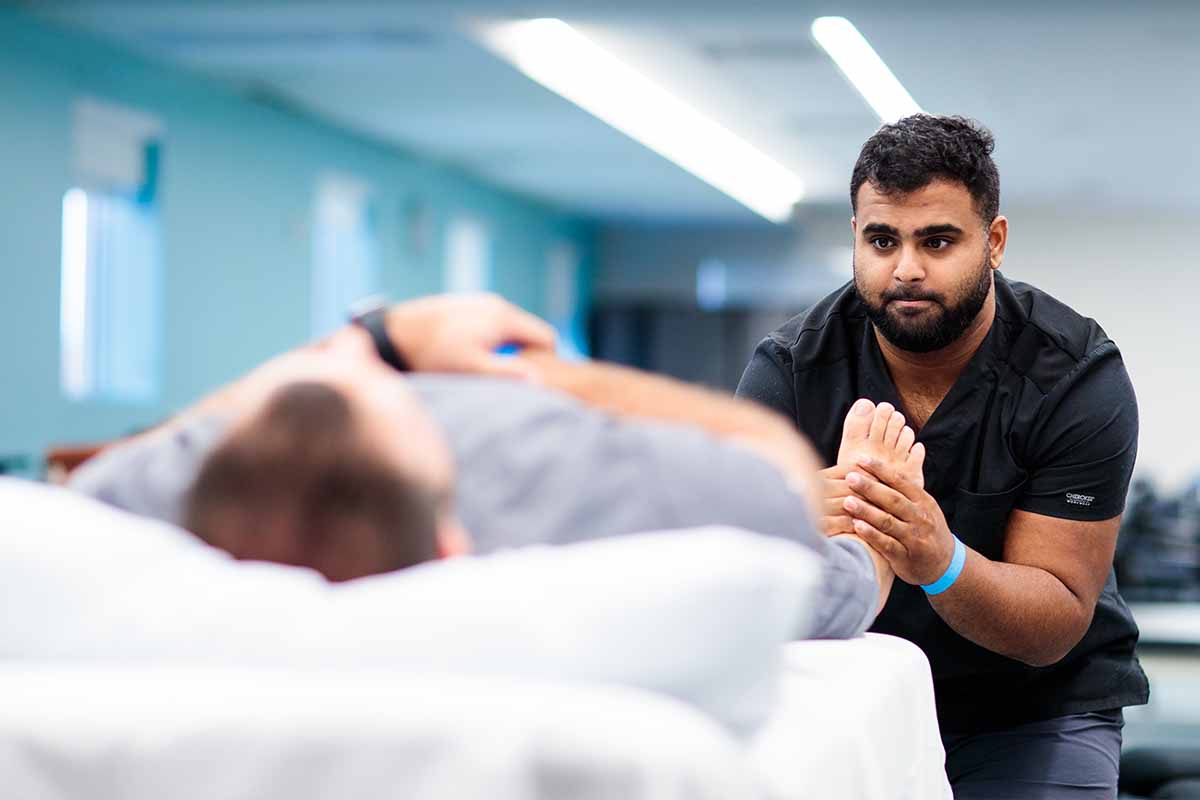
What does a physical therapist do? Also known as the movement expert, a PT practitioner has knowledge and training in human movement.1 Through hands-on treatment, physical therapists help patients recover from injury and live to their fullest potential.
Are you interested in a physical therapist career? You’ve come to the right place to find out if it’s the path for you.
We dive into the details of a typical physical therapist job description. Learn what physical therapists do, where they work, what level of education they need to practice, and what career paths are available to them.
Prepare to Become a Physical Therapist
What Do Physical Therapists Do?
Physical therapists help patients with injuries and chronic health conditions regain their range of motion, manage their pain and improve their quality of life.1 For example, if you need help managing lower back pain or recovering from an ACL tear, you would go to a physical therapist. The job description of a physical therapist involves treating musculoskeletal conditions and educating patients about staying fit and preventing future injuries.
Where Do Physical Therapists Work?
Physical therapists work in diverse settings alongside other health professions, from private clinics and hospitals to sports facilities. Many environments allow physical therapists to wear slacks with a dress shirt or comfortable scrubs.
A physical therapy job description will often be found in the following places:2
- Private practices
- Hospitals
- Schools
- Home health agencies
- Outpatient rehabilitation centers
- Nursing homes
Earning Potential for Physical Therapists
The average annual salary for a physical therapist nationally is $99,710 but can fluctuate depending on factors such as job title, work experience, education level, location and workplace.3 Physical therapy jobs are in high demand, with employment projected to grow 15% between 2022 and 2032, much faster than average across all occupations.3 This is expected to continue as the population ages and the need for professionals to take on physical therapist responsibilities and duties increases.
Physical Therapist Education Requirements
In order to fit the criteria of any physical therapy job description, you need to have a bachelor’s degree, preferably in a science-related field. Then, earn a Doctor of Physical Therapy (DPT) degree from a Commission on Accreditation in Physical Therapy Education (CAPTE) -accredited physical therapist program.1 The DPT program is the entry-level PT degree.
Most physical therapy education programs take three years or more to complete and include classroom work, hands-on lab activities and clinical education experiences. USAHS has an in-person program that can take as few as 7 trimesters or 2.3 years.*
Following graduation, you must pass the National Physical Therapy Examination (NPTE), administered by the Federation of State Boards of Physical Therapy (FSBPT). You must also pass your home state’s licensure exam. State requirements for licensure vary.
Request Information About USAHS’ DPT Program
Job Duties of a Physical Therapist
The job description for physical therapists includes working with patients to improve their movement and manage their pain with a treatment plan. PTs use a variety of techniques to help patients, including hands-on therapy, strengthening and stretching exercises, electrical stimulation, ultrasound and ice/heat.4
Physical therapist job responsibilities include working with patients who suffer from back and neck injuries, fractures, neurological disorders, work or sports-related injuries and other conditions.5 The treatments a physical therapist chooses will depend on the patient and their injury.
According to the Bureau of Labor Statistics (BLS), physical therapist duties and responsibilities may include:5
- Reviewing patient medical histories
- Diagnosing patients by observing their movements and listening to their concerns
- Developing individualized patient treatment plans
- Outlining clear patient goals and the expected plan outcomes
- Using exercises, stretching, equipment and hands-on therapy to manage patients’ pain, increase mobility and prevent further pain and injury
- Recording patient progress and modifying the plan of care if needed
- Educating patients and family members about the recovery process
Applying for the Right Program
The American Physical Therapy Association (APTA) does not rank Doctor of Physical Therapy (DPT) education programs. Instead, programs are accredited by the Commission on Accreditation in Physical Therapy Education (CAPTE) to ensure they meet quality standards. When choosing a DPT program, consider various factors:
- Cost and availability of financial aid. Many students graduate with student loans. Be aware of program expenses and have a plan to finance your education. Each program has a different cost and may offer a unique student experience.
- Duration of the program. The standard DPT program is three years, but some programs have condensed the academic requirements into a shorter period, which can aid in reducing the overall cost of your education and get you to work in the field sooner.
- Demographics and location of the program. As you invest in your physical therapy education, pick a program that aligns with your preferences and makes you feel comfortable. USAHS offers DPT programs across five campuses in U.S. destination cities: San Marcos, CA; St. Augustine, FL (our flagship location) and Miami, FL; Austin and Dallas, TX.


Job Skills
Being a PT can be mentally and physically draining. The responsibilities of a physical therapist require hands-on, individualized patient care.5 Some of the skills needed to fit the criteria of a physical therapist description are:
- Stamina
- Compassion
- Interpersonal communication skills
- Attention to detail
- Dexterity
- Creative problem solving
- Resourcefulness
- Time management
Career Paths for Physical Therapists
Physical therapy online courses offer several opportunities for advancement. You can choose to continue your education with a clinical residency or fellowship, or you can opt to specialize in one or more areas.6 Many PTs choose to become leaders in the field by opening a private practice.
Continuing Education
After earning a DPT degree, licensed physical therapists can pursue a residency or fellowship to further their education.6
- Clinical residency: USAHS offers a clinical orthopedic residency program as an optional, structured program that licensed physical therapists can take post-graduation. Typically completed in one-three years,* it is a clinical and didactic education that is designed to advance preparation for the variety of physical therapist responsibilities and duties within a specific area of practice.
- Clinical fellowship: A clinical fellowship follows the residency and is similar in structure. It is for physical therapists with substantial and demonstrable clinical experience who have a specialist certification or completed a residency in a related specialty.7
Certification and Specializations
Once they have significant experience with a variety of physical therapist duties and responsibilities, a PT can become board certified as a clinical specialist through the American Board of Physical Therapy Specialties (ABPTS) in one of several specialty areas, including:8
- Cardiovascular and Pulmonary
- Geriatrics
- Pediatrics
- Oncology
- Neurology
- Clinical Electrophysiology
- Orthopaedics
- Sports
- Women’s Health
- Wound Management
In order to become board-certified, applicants must pass an exam and complete an APTA-accredited residency program or at least 2,000 hours of direct patient care.9
Start Your PT Career Today
If you’re excited to help patients as a physical therapist, choose a physical therapy graduate school that offers a dynamic Doctor of Physical Therapy program that will challenge you to become a versatile, empathetic and autonomous practitioner. DPT programs like the path offered at USAHS provide you with the knowledge and skills to tackle physical therapist responsibilities and duties in any healthcare setting.
Learn More About Our PT Programs
**Based on total DPT degrees conferred during 2020-2022, as reported by the Integrated Postsecondary Education Data System (IPEDS). Data is captured by IPEDS through interrelated surveys conducted annually by the Department of Education’s National Center for Educational Statistics (NCES).
***The University of St. Augustine for Health Sciences (USAHS) is seeking approval from the Commission on Accreditation in Physical Therapy Education (CAPTE) for an expansion of its Doctor of Physical Therapy (DPT) program at its San Marcos, CA, and Miami, FL, campuses with a Hybrid Immersion model. Approval of the expansion programs is required prior to implementation.
Applicants interested in the Hybrid Immersion DPT format should contact an enrollment advisor using the request for information form on our site.
Salary data may not reflect starting pay for recent graduates.
Sources:
- Cleveland Clinic, “Physical Therapist,” Cleveland Clinic, 2024, https://my.clevelandclinic.org/health/articles/24625-physical-therapist.
- Mayo Clinic College of Medicine of Science, “Physical Therapist,” Mayo Clinic, 2023, https://college.mayo.edu/academics/explore-health-care-careers/careers-a-z/physical-therapist/.
- U.S. Bureau of Labor Statistics, “Physical Therapists: Summary,” Occupational Outlook Handbook, April 17 2024, https://www.bls.gov/ooh/healthcare/physical-therapists.htm.
- Traci Pedersen, “What Are the Types of Physical Therapy,” Healthline, July 17, 2023, https://www.healthline.com/health/types-of-physical-therapy.
- U.S. Bureau of Labor Statistics, “Physical Therapists: What Physical Therapists Do,” Occupational Therapy Handbook, April 17, 2024, https://www.bls.gov/ooh/healthcare/physical-therapists.htm#tab-2.
- American Physical Therapy Association, “Becoming a Physical Therapist,” APTA, 2024, https://www.apta.org/your-career/careers-in-physical-therapy/becoming-a-pt.
- AAOMPT, “Residency vs Fellowship,” 2024, https://aaompt.org/Main/Main/Education/Difference.aspx.
- American Physical Therapy Association, “Specialist Certification,” APTA, 2024, https://www.apta.org/your-career/career-advancement/specialist-certification.
- American Physical Therapy Association, “Minimum Eligibility Requirements and General Information for All Physical Therapist Specialist Certification,” APTA, 2024, https://specialization.apta.org/become-a-specialist/minimum-requirements.









